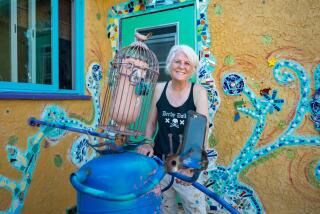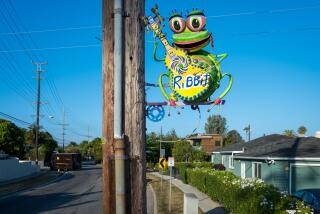ART : Laguna Beach City Hall Caught in a State-of-the-Art Squabble
An unfinished drama is being staged in the city of Laguna Beach these days. The plot may seem pretty boring--something about the fate of a sculpture proposed for the front of City Hall. But this is really a human comedy about clashing visions, lack of power in key positions and the folly of inexperience. Admission is free, and the show seems likely to continue for at least another month.
Prologue
According to a 1986 addition to the municipal code, Laguna Beach developers working on projects costing more than $225,000 are required to reserve 1% of estimated building costs for a work of art.
So the Laguna Beach Arts Commission reminds the city that this new ordinance applies to City Hall, where no provision for art has been made. Then the commission is informed by the city that a work of art can be placed on a small, wedge-shaped plot. After the commission complains that the spot is inappropriate, the city agrees to take out a few trees and provide a bit more space. So, rather than setting the tone for public art in Laguna Beach, the commission is reduced to being grateful for small favors.
Nothing daunted, in the summer of 1990 the commission holds what it calls a national competition for a sculptural fountain to be placed in front of City Hall, which is being remodeled. Never mind that $27,000 (1% of $2.7 million) is chicken feed in the world of public art or that the competition is advertised exactly once, in Artweek magazine.
The commission appoints a jury--an artist, two museum directors and an experienced arts professional--to meet with Mayor Neil Fitzpatrick and winnow down the 56 artist entries to two finalists.
Act I: Fall 1990
Former Arts Commission chairwoman Leah Vasquez suggests that the fountain idea be expanded by turning a half-block area of Loma Terrace, in front of City Hall, into an “arts plaza.” The Arts Commission likes the idea, but Police Chief Neil Purcell and City Manager Kenneth C. Frank nix it, citing potential safety hazards.
Meanwhile, the jury selects Tom Askman of Spokane, Wash., and Pat Warner of Los Angeles as the two finalists. Askman’s piece is aggressively busy and playful; Warner’s is quiet and simple, some might say dull.
In the Askman piece, water spurting from a cantilevered 12-foot-tall octagonal bronze cone flows over another, smaller cone. Passersby can choose to walk under the big cone, walk through the waterfall (and get wet) or simply view the sparkling falling water from a dry distance.
The Warner piece, modeled after a traditional village well, is called “Tinaja” after the Spanish name for Southern California’s rock-lined natural pools. The adobe-colored concrete fountain contains a shallow pool in the middle, fed by water from an 8-foot-long bronze trough, and a continuous ledge that can be used for seating. Warner writes that her piece is made to blend with the “traditional architecture” of the area.
The Askman piece is the unanimous first choice of the Arts Commission, which sends both finalist designs to City Council.
Act II: Spring 1991
But the council delays making a decision. Instead, Mayor Fitzpatrick--who has been outspoken about his preference for a more traditional design--calls for reviews of the sculptures by the city’s Heritage Committee, Design Review Board and Beautification Council.
At a March 11 meeting at City Hall, attended by about two dozen people, the Arts Commission explains the selection process, discusses the two finalist works, and solicits opinions from the public--which mainly consist of a brief volley of negative opinion.
Phyllis Willats of the Laguna Beach Beautification Council faults both sculptures for being abstract and not “representing” the city with a “traditional theme.” She says the sculptures failed to make a statement about the city’s “international reputation as a historic ocean resort and art colony.”
Helen McPherson of the Heritage Committee asks if anyone had considered memorial plaques to outstanding city residents. She says city residents are telling her the two proposed sculptures are “too modern.” But she sounds pleased to have learned that the surface of “Tinaja” can be “made to look very old.”
Bob Borthwick, a landscape architect, suggests that the Askman piece would be “a nice focal point for a museum of art, not on a street corner.” He says he “kept hearing over and over that the things people remembered were traditional pieces.”
There are a few voices raised in favor of moving ahead with the project as already conceived. A couple of people mention major public designs markedly different from their environments--Maya Lin’s Vietnam Memorial in Washington and Renzo Piano’s Pompidou Center in Paris--that were unveiled to a storm of public disapproval, but have become warmly accepted over the years.
But no one addresses the main problems of the sculpture competition--that, for all its good intentions, it lacks focus and clout.
Act III: The Future
The sculpture issue is supposed to be on the agenda of the April 16 City Council meeting.
It may seem appealing to call the public art program “an art gallery in the streets of Laguna Beach of museum quality art,” in the words of Kay Ogden, Art Commission chairwoman. But the art gallery motif allusion is misleading. The most important job public art does is to celebrate the spirit of a particular place.
The point is not to plunk down an object on a plot of land nobody else is using, but to add a coherent focal point to an architectural setting. The best solution may be a sculpture, a plaza, a bench, a walkway, a pocket park or something else entirely.
If the Arts Commission had hired a professional adviser familiar with the complex and tedious process of making good public art happen, it might not have gotten locked into the idea of putting a fountain sculpture (whose idea was that, anyway?) on a plot of land somebody else picked out.
Sure, the tiny budget was a problem, but the commission could have tapped the municipal “in lieu” fund, in which developers who choose not to place art on their building sites must deposit 1% of their building costs.
Rather than waiting until competition finalists have been determined to invite opinion from other citizen groups, public opinion could have been canvassed in an aggressive way at the outset.
A professional adviser could have organized a public slide show of innovative solutions in other communities, while gently conveying the message that a sculpture--whether abstract or figurative, incorporating water or not--is only one alternative. The issue of where to site the piece could have been thoroughly aired.
And the adviser (or perhaps a trained “facilitator”) could have led a series of public discussions about the landscape, ethos and activities of a city that--for better or worse--is undergoing enormous change.
The remaining wildlife in the hills, the dazzling shoreline views, the live-and-let-live small-town atmosphere, the glitzy boutiques, the tacky T-shirt shops, the bathers and strollers and ice cream cone slurpers, the arts-and-crafts contingent, the old-fashioned painters, the yuppie condo dwellers, the back-to-the-’60s folks in Canyon Acres, the gay community, the tourists--all are part of the scene.
The point isn’t that the public art piece would literally incorporate such elements, but that the public would feel involved in the process and more aware of what public art can communicate. At the same time, artists working on the project might have a better sense of what today’s Laguna Beach is all about.
Of course, an artist working on a public project does have to visit the site. The amateur homemade videotape of Laguna Beach streets that commissioner C.H. Boyd sent to Askman was not one of the commission’s better concepts. Why wasn’t there a travel allowance for out-of-town finalists to visit the city?
In terms of the larger art world of museum curators and critical appraisals, “Laguna Beach artist” has become a phrase said with a smile, if it is said at all. Only the tourists and the old-time artists cling to the old notion of a distinguished art community--the same people who are still getting mileage out of the hoary fight between realism and abstraction. Still, the consensus at the March 11 meeting was that Laguna Beach would lose its credibility in the art world if the competition were abandoned at this point.
If the city does move ahead with the project, the Askman piece is certainly the more lively and amusing entry. By chance, the “tensions” it embodies even reflect the city’s contemporary mood, as developers and environmentalists continue to battle over the quality of life.
Perhaps Askman could be flown down to Laguna so that he could better adapt his vision to the site. But if the City Council rejects both designs--which is entirely possible--maybe the art commissioners will learn to play a tougher game. Maybe they will locate heavyweight art-in-public-places experts to help make their case compelling and involve the public and officials--who always know what they don’t like--in a timely, instructive yet controlled way. Call it a learning curve, and don’t ring down the curtain just yet.
More to Read
The biggest entertainment stories
Get our big stories about Hollywood, film, television, music, arts, culture and more right in your inbox as soon as they publish.
You may occasionally receive promotional content from the Los Angeles Times.










